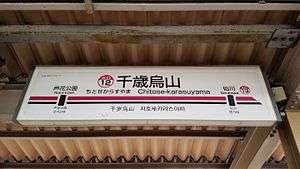Chitose-karasuyama Station
Chitose-Karasuyama Station (千歳烏山駅, Chitose-karasuyama-eki) is a railway station on the Keio Line in Setagaya, Tokyo, Japan, operated by the private railway operator Keio Corporation.[1] It is the westernmost station of the Keio Line in the 23 special wards of Tokyo. Trains cross the Setagaya-Chōfu border west of the station.
Chitose-karasuyama Station 千歳烏山駅 | |
|---|---|
 | |
| Location | 6-1-1 Minami-Karasuyama, Setagaya, Tokyo (東京都世田谷区南烏山6-1-1) Japan |
| Operated by | Keio Corporation |
| Line(s) | Keio Line |
| Connections |
|
| Other information | |
| Station code | KO12 |
| History | |
| Opened | 1913 |
| Previous names | Karasuyama (until 1929) |
| Traffic | |
| Passengers (FY2011) | 74,518 daily |
| Location | |
 Chitose-Karasuyama Station Location within Special wards of Tokyo  Chitose-Karasuyama Station Chitose-Karasuyama Station (Japan) | |
Station layout
The station has two ground-level side platforms serving two tracks. Both platforms are connected by stairs to two small underground concourses beneath the tracks.
Platforms
| 1 | KO Keiō Line | for Chōfu, Keiō Hachiōji KO Keio Takao Line for Takaosanguchi KO Keio Sagamihara Line for Hashimoto |
| 2 | KO Keiō Line | for Meidaimae, Sasazuka, and Shinjuku KO Keio New Line for Shinjuku S Toei Shinjuku Line for Motoyawata |
Adjacent stations
| ← | Service | → | ||
|---|---|---|---|---|
| Keio Line | ||||
| Keiō Liner: Does not stop at this station | ||||
| Special Express: Does not stop at this station | ||||
| Meidaimae | Semi Special Express | Chōfu | ||
| Sakurajōsui | Express | Tsutsujigaoka | ||
| Sakurajōsui | Semi Express | Sengawa | ||
| Hachimanyama | Rapid | Sengawa | ||
| Roka-kōen | Local | Sengawa | ||
History
The station opened on April 15, 1913 as Karasuyama Station (烏山駅).[2] It was renamed Chitose-Karasuyama on 7 August 1929.[2]
Passenger statistics
In fiscal 2011, the station was used by an average of 74,518 passengers daily.[2]
Surrounding area
On both the north and south sides of the station lie large shopping districts. Just north of the station is the Karasuyama District Administration Office.
References
- "Keio Railway Map & Reading Station Signs - Keio Corporation".
- Terada, Hirokazu (19 January 2013). データブック日本の私鉄 [Databook: Japan's Private Railways]. Japan: Neko Publishing. p. 228. ISBN 978-4-7770-1336-4.
External links
| Wikimedia Commons has media related to Chitose-Karasuyama Station. |
- Keio station information (in Japanese)